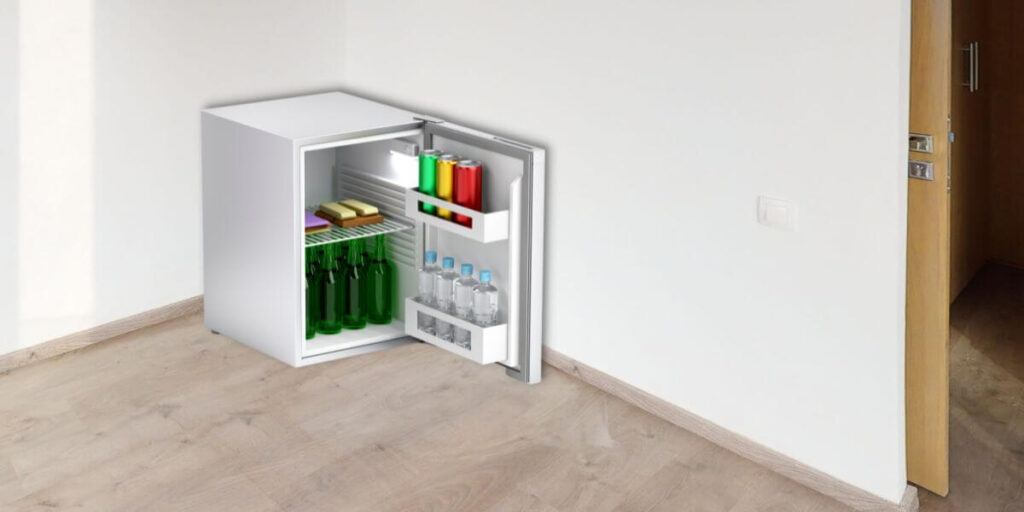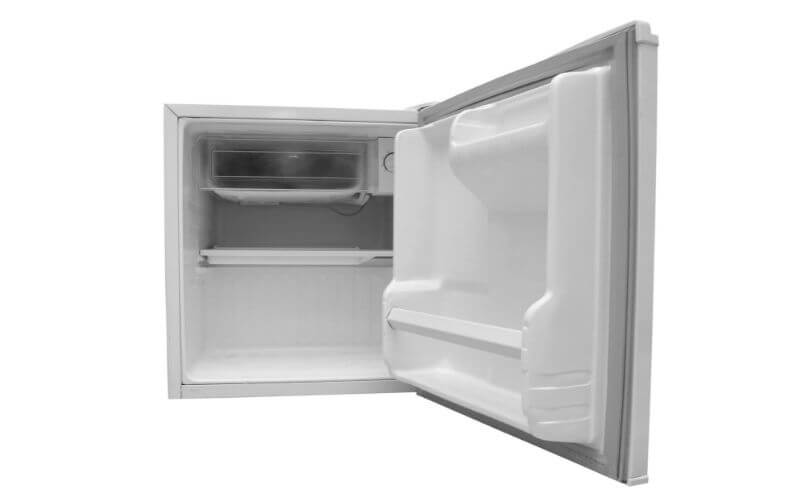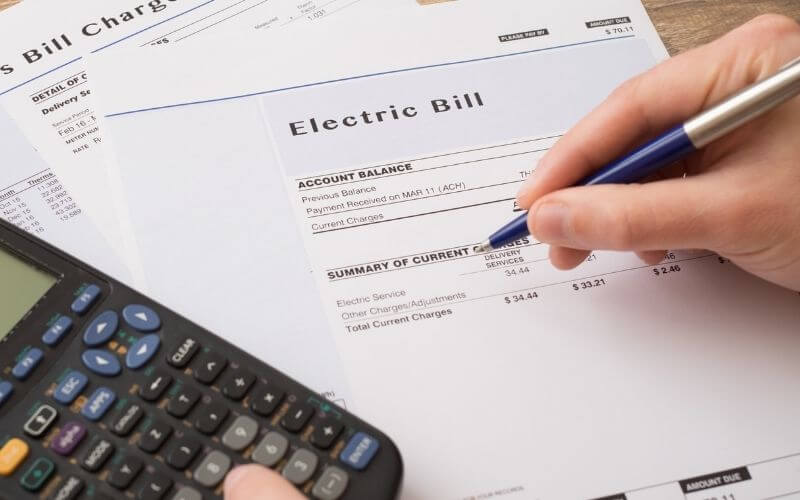Mini fridges vary in size and power from small, desktop mini fridges that hold only a couple of cans of soda or a few cosmetics, to small refrigerators with freezers that are capable of chilling enough groceries for one or two people.
To find out how much electricity the average mini fridge uses, I spent over 8 hours analyzing the power consumption of 1,359 mini fridges in the United States.

In this guide, I’ll explain exactly how much it costs to run a mini fridge, both in terms of watts of electricity and in terms of how much it will add to your electricity bill.
Then, you’ll know if the convenience of cold drinks and snacks is worth the cost, or if you should consider another option like a cooler or even a solar-powered mini fridge.
How much electricity does a mini fridge use?
A mini fridge can use anywhere between 7 and 73 kWh of electricity per month, with the average being 27 kWh per month. The average mini fridge costs around $3-4 per month to run, but this can vary hugely depending on factors like the size and efficiency of the fridge, the climate and energy costs where you live, and how often the door is opened.
The following table shows how much you can expect to spend on running a mini fridge:
| Cost to Run | Minimum | Average | Maximum |
|---|---|---|---|
| Hourly | $0.002 | $0.006 | $0.016 |
| Daily | $0.04 | $0.14 | $0.39 |
| Monthly | $1.12 | $4.32 | $11.68 |
| Yearly | $13.44 | $51.84 | $140.16 |
This data is based on an average electricity cost of $0.16 per kWh according to the US Energy Information Administration.
However, electricity costs vary a lot depending on where you live. In New England, Alaska and Hawaii, electricity can cost more than double the US average.
As you can see, it’s worth taking a little time to choose an energy-efficient mini fridge as this can save you a lot of money on your electricity bill over time.
The model that I recommend is this Black & Decker Mini Fridge mini fridge as it uses only 212 kWh per year, so costs under $3 per month to run.

This compact refrigerator is perfect to use in your home or RV as it has a decent capacity of 2.5 cubic feet, meaning that you can store 2 later bottled as well as cans of soda or beer.
I have some more efficient mini fridge recommendations further down in this guide.
Mini Fridge Power Consumption
Mini fridges don’t run constantly. Instead, they cycle on and off as needed, using more power as when the door is opened or the outside temperature rises. Because of this, you cannot just look at the wattage of the mini fridge to work out how much electricity it uses.
The average mini fridge has a wattage of 50 to 65 watts. This depends on the size and insulation of the appliance.
The actual power consumption of a mini fridge depends on the following factors:
1. Size of the fridge
While larger fridges generally use more energy, smaller fridges consume more energy per cubic foot. So the smaller the fridge, the more it will cost to chill each can of soda.
2. Age of the fridge
Older refrigerators are generally less energy-efficient than modern ones. While vintage mini fridges may look cool, those built in the 1970s may use five times more electricity than newer models.
3. The energy efficiency of the fridge
New fridges will have a yellow EnergyGuide label which shows how much energy the appliance uses and how much it will cost to run. An ENERGY STAR-certified refrigerator will cost around $55 less to run over its lifetime.
4. Whether the fridge has a freezer compartment
You can expect your mini fridge to use around 20% more electricity if it has a freezer section.

5. Whether the fridge is a silent model
They’re good to use in the bedroom, but quiet refrigerators can use double the electricity of a louder model as the technology works non-stop, whereas standard models use the compressor only intermittently.
6. The temperature setting that’s used
If you don’t need drinks to be ice-cold, consider turning the temperature of the fridge down to save money.
7. The temperature of the room
Mini fridges use more power in summer because the air around them is warmer.
8. How full the fridge is
The energy ratings you see on the label are based on an empty fridge, but the efficiency will drop the fuller it gets.
9. Opening the door
Each time you open the door to your fridge, cool air escapes. Aim to open and close the door as quickly as possible to reduce the impact.

Does a mini fridge use a lot of electricity?
A mini fridge uses quite a lot of electricity compared to other household appliances. While mini fridges use around half of the electricity of a full-size fridge, they’re much smaller, so less efficient overall. As they’re usually kept plugged in all of the time, the energy usage can add up to as much as $100 per year.
The table below shows the energy consumption of a mini fridge compared to other household appliances.
| Appliance | kWh per hour of use | Cost per hour |
|---|---|---|
| 20W LED lightbulb | 0.02 | $0.003 |
| Pedestal fan | 0.03 | $0.005 |
| Mini fridge | 0.04 | $0.006 |
| Full-size fridge | 0.08 | $0.013 |
| Laptop computer | 0.35 | $0.056 |
| Vacuum cleaner | 0.75 | $0.12 |
| Microwave oven | 1.44 | $0.23 |
| Portable heater (1500W) | 1.5 | $0.24 |
Mini Fridge Electricity Cost
How much does it cost to run a mini fridge?
Running a mini fridge costs between 3 cents and 29 cents per day, with the average mini fridge costing 11 cents per day to run.
This equates to around $3-4 per month on top of your electricity bill.
The exact amount will depend on the wattage of your fridge, the exact usage conditions, and how much your supplier charges for electricity.
Will a mini fridge increase the electricity bill?
Getting a mini fridge will undoubtedly increase your electricity bill by a few dollars each month. However, the installation of a mini fridge will have a knock-on effect on the energy usage of your other household appliances.
Mini fridges expel warm air out of the back. This is fine if you live in a cold climate, but if you’re also using electricity for air conditioning or fans, then you will need to use these slightly more to counteract the heat produced out of the back of your fridge.
In some cases, a mini fridge can actually lower your overall energy bill. This is because every time you open a fridge, some cool air is lost, so the appliance will draw more power.
If the use of a mini fridge reduces the number of times that you open your main full-size kitchen refrigerator, then this will lower the cost of running the main fridge.

Find out exactly how much power your mini fridge is using
Because there are so many factors affecting the power consumption of mini fridges, any info given in this article is just a guide to the averages. You can get an accurate reading of exactly how much energy your mini fridge uses with a power meter.

This electricity usage monitor is simple to use – You just connect it to a standard outlet and plug your device into it to know exactly how much it uses.
The Most Energy Efficient Mini Fridges
To help you find the best energy-efficient mini fridge, here are the most highly-rated ones I’ve come across during my extensive research.
Best Low-Energy Mini Fridge

Best Energy-Efficient Mini Fridge With Freezer

Best Bar-Style Mini Fridge

Tips to Lower Your Mini Fridge Electricity Costs
Finally, here are some tips to help you to lower the running costs of your mini fridge…
1. Clean the coils
Condensor coils do most of the work in terms of cooling and if they become dirty they have to work harder and use more electricity.
You’ll find the coils weather on the back of the mini fridge or under a grill on the front. Simply unplug the fridge and use a vacuum to remove the dust to improve the efficiency of your appliance.

2. Leave some space at the back
Mini fridges kick out heat at the back so you’ll want to leave a couple of inches of space between the back of the fridge and the wall so that this air can move away. If it can’t, the fridge will have to use more power to cool itself.
3. Adjust the temperature
The ideal temperature for a refrigerator is between 36° and 38°F. Not every mini fridge will tell you the temperature and even if yours does, this isn’t always reliable.
Pop a thermometer inside to check that yours is the right temperature to balance cooling and cost.

4. Check the door seals
One of the main reasons that fridges become less efficient as they get older is because the door seals wear away, allowing cold air to escape.
An easy way to test your mini fridge door seals is to put a dollar bill in the door as you close it. If you can easily slide the bill out with the door closed, then your door seals need replacing.

5. Choose the position carefully
Mini fridges work most efficiently when they’re in a cool spot. If yours is in direct sunlight or next to another appliance such as a cooker or dishwasher, then consider moving it to somewhere cooler.
The Bottom Line
It’s not possible to say for sure exactly how much electricity a mini fridge uses as they vary quite a lot. However, if you choose a new energy-efficient model and use it sensibly, then you can expect that your electricity bill will only rise by a couple of dollars per month.
Having a mini fridge in your home is certainly a luxury. But, if you want a mini fridge to use in your RV, car, or for camping, then you’ll be pleased to know that mini fridges don’t always need a lot of electricity to run. You can run a small fridge or electric cooler off solar power or a 12V car battery if needed.
